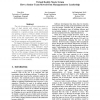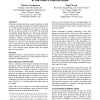271 search results - page 10 / 55 » Making games for social change |
HICSS
2011
IEEE
12 years 11 months ago
2011
IEEE
The role of managers in a Scrum organization is a topic of high interest with almost no research. Changes in management roles and behaviors were evaluated in a rapidly growing, so...
ATAL
2004
Springer
14 years 1 months ago
2004
Springer
We introduce a Game Logic with Preferences (GLP), which makes it possible to reason about how information or assumptions about the preferences of other players can be used by agen...
HT
2009
ACM
13 years 11 months ago
2009
ACM
We introduce four measures for the change of coalitions in social networks. The first one measures the change of the agents in the network over time, The second one measures the ...
HICSS
2007
IEEE
14 years 2 months ago
2007
IEEE
Massive, multiplayer online role-playing games foster rich social environments. Within the game, players can interact with other players, make friends, create and cultivate new on...
CHI
2001
ACM
14 years 8 months ago
2001
ACM
In human-to-human interaction, people sometimes are able to pick up and respond sensitively to the other's internal state as it shifts moment by moment over the course of an ...


